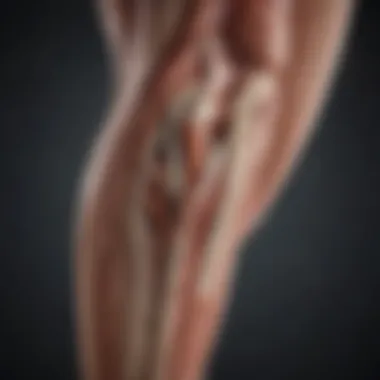Understanding and Managing Nighttime Calf Cramps Effectively


Intro
Nighttime calf cramps present a widespread issue, affecting individuals of varying age groups and lifestyles. These involuntary muscle contractions often occur during periods of rest, leading to significant discomfort and sleep disruption. Understanding the anatomy and mechanics of these cramps is essential for developing effective management strategies.
The muscles in the calf—primarily the gastrocnemius and soleus—play a key role in movement and stability. When these muscles contract and fail to relax, the result is a cramp that can range in intensity from mild discomfort to severe pain. While the exact cause remains somewhat elusive, a combination of physiological, nutritional, and environmental factors contribute to their onset.
In this article, we will explore the background of nighttime calf cramps, examining their possible triggers, associated risk factors, and practical tips for prevention and relief. The goal is to equip health professionals, wellness coaches, nutritionists, fitness trainers, and mindfulness instructors with a comprehensive understanding that can be relayed to those experiencing this common concern.
Key Takeaways
- Nighttime calf cramps are involuntary muscle contractions often experienced at rest.
- Key risk factors include dehydration, electrolyte imbalances, and muscle fatigue.
- Effective management may include stretches, dietary adjustments, and hydration strategies.
- Understanding individual triggers can help develop personalized approaches to prevention and treatment.
In-Depth Analysis
Nighttime calf cramps can arise from various causes, with research indicating that dehydration is one of the most prevalent risk factors. Maintaining proper hydration influences muscle function and overall health. Additionally, low levels of essential minerals such as potassium, calcium, and magnesium can significantly impact muscle contractions.
Several studies have highlighted the correlation between stretching before bedtime and the reduction of cramp occurrences. A randomized controlled trial published in the Journal of Clinical Neurology suggested that a simple calf stretching regimen could reduce both the frequency and intensity of nighttime cramps.
Furthermore, lifestyle factors contribute to muscle health. Standing or sitting for prolonged periods can lead to fatigue in the calf muscles, increasing the likelihood of cramping during sleep. Adjusting daily habits to include regular movement and strengthening exercises can promote better overall muscle function.
Key Recommendations:
- Stay hydrated: Aim for adequate fluid intake throughout the day.
- Monitor diet: Ensure adequate intake of potassium, calcium, and magnesium.
- Incorporate stretches: A nightly stretching routine may help prevent cramps.
"Understanding the body's signals is paramount. By recognizing the signs of fatigue, dehydration, or nutrient deficiency, effective management becomes possible."
Preface to Nighttime Calf Cramps
Nighttime calf cramps represent not only a common ailment but also a significant sleep disruptor for many individuals. Understanding these cramps requires an exploration of their physiological basis, common triggers, and impact on daily life. Individuals experiencing these involuntary muscle contractions during sleep often find themselves startled awake. This episode is not only uncomfortable but can also lead to ongoing anxiety about future occurrences.
Grasping the importance of this topic can ultimately aid both the general public and professionals in identifying effective methods for prevention and management. Addressing calf cramps goes beyond immediate relief; it also ties into broader issues such as hydration, nutrition, sleep quality, and general muscle health. By delving deeper into the causes and potential remedies, it becomes clear that this is not merely a physical challenge but one that resonates emotionally and psychologically, affecting an individual's overall well-being.
Definition of Calf Cramps
Calf cramps are defined as sudden, involuntary contractions of the calf muscles. These cramps can occur while a person is at rest or during sleep and often last from a few seconds to a couple of minutes. They manifest as a sharp pain, typically felt in the back of the lower leg, and can be debilitating enough to require stretching or movement to alleviate the discomfort. The pain is a direct result of the muscle fibers being unable to relax after a contraction, leading to muscle tightness and spasms.
In clinical terms, calf cramps can be categorized as either nocturnal cramps—those occurring during sleep—or exercise-associated cramps, which can occur during physical activity. Both types can lead to significant distress, especially if they are recurrent.
Prevalence Among Different Age Groups
Calf cramps can affect individuals of all age groups, yet their prevalence fluctuates considerably across different demographics. Older adults often report a higher incidence of nighttime cramps. This may be linked to age-related muscle loss and dehydration. Conversely, young and athletic individuals may experience cramps due to overexertion or inadequate hydration.
Studies reveal that:
- Approximately 60% of older adults report experiencing nighttime cramps.
- Athletes, especially those engaged in endurance sports, can also exhibit symptoms, often due to electrolyte imbalances.
In children, the condition is rare but not unheard of, usually associated with growth spurts or sudden changes in physical activity levels.
Understanding these variances is crucial for developing targeted interventions that cater to the specific needs of each demographic. Recognizing preventative measures and management strategies can greatly improve quality of life for those affected by this common issue.
Physiology of Muscle Cramps
Muscle cramps, particularly in the calves, are complex phenomena that indicate a disconnect between the muscle's biochemical and neurological responses. This section dives into the intricate physiology of muscle cramps, providing a foundational understanding important for both prevention and treatment strategies. Understanding muscle physiology is critical as it lays the groundwork for comprehending the underlying causes of cramps and potential management pathways.
Understanding Muscle Contraction
Muscle contraction is a finely-tuned process, primarily driven by the interaction of actin and myosin filaments. When a nerve stimulates a muscle, calcium ions are released, triggering this actin-myosin interaction, resulting in muscle shortening and force generation.
However, several factors can disrupt this cycle, leading to cramps:
- Overstimulation: Excessive stimulus from the nervous system can cause prolonged contraction without relaxation.
- Fatigue: Muscles that are fatigued do not contract efficiently, and their recovery phase is often delayed.
- Coordination: Issues with neuromuscular coordination can cause the muscles to contract too forcefully.
The importance of this understanding lies in pinpointing why some individuals are more prone to cramps. Factors like the intensity of physical activity, as well as pre-existing muscle conditions, can exacerbate susceptibility.


The Role of Electrolytes
Electrolytes play a crucial role in muscle function and overall health. Key electrolytes such as sodium, potassium, calcium, and magnesium facilitate the electrical signals needed for muscle contraction and relaxation. An imbalance in these electrolytes can significantly contribute to the onset of muscle cramps.
The various functions of electrolytes include:
- Sodium: This is essential for maintaining fluid balance and transmitting nerve impulses, crucial for muscle activation and relaxation.
- Potassium: It contributes to muscle contraction by facilitating electrical signaling between nerves and muscles.
- Calcium: It is essential for the initiation of contraction; without adequate levels, muscles may not function optimally.
- Magnesium: Acts as a natural calcium blocker; when deficient, it can lead to excessive contractions, resulting in cramps.
"Electrolyte balance is crucial for preventing muscle cramps and ensuring proper muscle function. "
Understanding these physiological aspects is vital for health professionals and coaches looking to address and manage nighttime calf cramps effectively. Through proper assessment of muscle physiology and electrolyte roles, tailored recommendations can be made to mitigate cramps and optimize muscle health.
Common Causes of Nighttime Calf Cramps
Understanding the common causes of nighttime calf cramps is vital for anyone experiencing these painful episodes. Identifying the root causes helps in tailoring prevention strategies. By focusing on elements such as dehydration, nutritional deficiencies, and lifestyle choices, one can uncover the underlying issues that contribute to these cramps. Addressing these factors may lead to better management and an enhanced quality of life.
Dehydration and Its Implications
Dehydration plays a significant role in the occurrence of calf cramps. When the body lacks adequate fluids, muscle function deteriorates. This can create an environment for cramps to happen. Individuals who engage in physical activity, particularly in warm climates, are at higher risk. Lack of water affects the electrolyte balance, which is essential for muscle contraction and relaxation. Inadequate hydration may manifest as increased muscle fatigue and cramping, especially at night when muscles are supposed to relax.
Key strategies to combat dehydration include:
- Regularly consuming water throughout the day.
- Monitoring fluid intake before, during, and after physical activities.
- Including electrolyte-rich beverages when necessary, especially after sweating.
Nutritional Deficiencies
Nutritional deficiencies are another significant contributor to nighttime calf cramps. Essential minerals like magnesium, potassium, and calcium are crucial for muscle health. A deficit in any of these can disrupt normal muscle functioning, leading to cramps.
Magnesium Deficiency
Magnesium deficiency is a prevalent issue that affects muscle relaxation. Magnesium is a muscle relaxant, and when the body is low in this mineral, muscles may spasm more easily. Recovery from physical stress is also hindered in magnesium deficiency. This deficiency can often go unnoticed until noticeable cramping occurs.
Unique features of magnesium deficiency include:
- Associated symptoms like fatigue and muscle tension.
- Common sources of magnesium, such as nuts, seeds, and leafy green vegetables.
Potassium Deficiency
Potassium deficiency also contributes significantly to calf cramps. Potassium is vital in managing fluid levels and muscle contractions. A lack of potassium can lead to severe muscular weakness and cramping. Many people are unaware of how dietary choices can contribute to this deficiency, particularly if they consume insufficient fruits and vegetables.
Key aspects of potassium deficiency:
- Symptoms include muscle cramps, weakness, and fatigue.
- Foods rich in potassium include bananas, oranges, and potatoes.
Calcium Impact
Calcium's impact on muscle function is critical. It plays a major role in muscle contraction. When calcium levels drop, muscles may become more prone to cramping. This deficiency is particularly problematic for older adults, who may already have a decreased intake of calcium due to dietary restrictions or absorption issues.
Understanding calcium's unique features:
- Calcium is fundamental for both muscle contraction and relaxation.
- Common dietary sources include dairy products, fish, and fortified foods.
Adopting a balanced diet that includes sufficient amounts of these minerals is crucial in preventing nighttime calf cramps. Consequently, individual awareness of their diet plays a key role in maintaining muscle health.
Lifestyle Factors Contributing to Cramps
Lifestyle choices directly impact the occurrence and management of nighttime calf cramps. Understanding these factors can pave the way for effective prevention strategies. This section highlights key elements that play a crucial role in muscle health, offering insights tailored for health professionals, wellness coaches, and fitness trainers.
Physical Activity Levels
Regular physical activity is essential for maintaining muscle function and preventing cramps. Engaging in consistent exercise helps promote circulation and flexibility, which are vital for muscle health. If physically inactive, muscles can become stiff and more prone to cramping.
When considering exercise routines, it is essential to include both aerobic activities, like walking or running, and strength-training exercises. Stretching is also a critical component. Incorporating stretching before and after workouts can further enhance flexibility and reduce cramping risk.


Impact of Sedentary Lifestyle
A sedentary lifestyle can lead to several issues related to muscle function. Sitting for extended periods can cause blood flow to stagnate, resulting in muscle stiffness and tension. Muscle tension increases the likelihood of experiencing cramps during the night.
To mitigate these effects, it is important to integrate movement into daily routines. Simple activities, such as standing or walking for short periods, can significantly reduce muscle tightness. Incorporating breaks during long periods of sitting can foster better circulation and decrease cramp frequency.
Footwear Choices and Posture
The choices made in footwear play a significant role in muscle health and cramping. Ill-fitting shoes or high heels can change posture and exert undue stress on calf muscles. This stress can lead to muscle fatigue, making cramps more likely during the night.
Investing in supportive footwear that promotes proper alignment can help alleviate unnecessary strain. Moreover, one should also pay attention to posture throughout the day; maintaining a neutral spine and proper alignment can prevent muscle overuse and stiffness.
In summary, by addressing these lifestyle factors—activity levels, sedentary habits, and footwear choices—individuals can manage and prevent nighttime calf cramps effectively. Better awareness and proactive actions in these areas form the foundation for improved muscle health.
Health Conditions Linked to Cramps
Understanding the connection between certain health conditions and nighttime calf cramps is crucial for managing the discomfort they bring. While cramps can often result from lifestyle choices or nutritional deficiencies, underlying health conditions may exacerbate or even cause these cramps. By identifying any associated medical issues, individuals can approach treatment and prevention more effectively. This knowledge may lead to better overall health and a reduction in the frequency and severity of cramps.
Diabetes and Circulatory Issues
Diabetes is one of the primary health concerns linked to nighttime calf cramps. High blood sugar levels can lead to various complications, including damage to blood vessels. Poor circulation in the legs, often seen in people with diabetes, contributes to muscle cramps. The interaction between nerve damage and compromised blood flow complicates this issue even further. Consequently, individuals with diabetes should monitor their blood sugar levels consistently and work on improving their circulatory health, which may include exercise or other lifestyle changes.
Peripheral Artery Disease
Peripheral artery disease (PAD) is another significant concern when discussing calf cramps. In PAD, narrowed arteries restrict blood flow to the limbs, leading to cramping and discomfort, especially during physical activity and even at rest. Like diabetes, poor blood circulation plays a key role here. Symptoms related to PAD can worsen over time, making early detection essential. Individuals diagnosed with PAD often benefit from tailored exercise programs and lifestyle changes, which can improve blood flow and decrease the occurrence of cramping.
Neurological Disorders
Neurological disorders can also contribute to nighttime calf cramps. Conditions such as multiple sclerosis and Parkinson's disease can alter nerve function. These changes may lead to involuntary muscle contractions, contributing to cramps during sleep. Moreover, medications used for treating these disorders may have muscle cramping as a side effect. Patients experiencing cramps alongside these disorders should consult their healthcare provider for appropriate management strategies.
Understanding the underlying health conditions linked to calf cramps enables targeted approaches to treatment, improving sleep quality and overall health.
Preventive Measures for Calf Cramps
Preventing nighttime calf cramps is crucial for maintaining overall muscle health and ensuring a good night’s sleep. Implementing effective preventive measures minimizes the likelihood of cramps occurring and enhances approach to managing muscle discomfort. Various strategies focus on hydration, nutrition, and physical activity, all of which play a vital role in alleviating this condition. Understanding each aspect of these preventive measures can lead to better outcomes and improved quality of life.
Hydration Strategies
Proper hydration is fundamental in reducing the occurrence of calf cramps. When the body is dehydrated, muscles can become more susceptible to cramping due to a lack of electrolytes and fluids, which are necessary for muscle function. Drinking fluids consistently throughout the day rather than in large quantities at once will help maintain optimum hydration levels.
Incorporating water-rich foods like cucumbers, tomatoes, and watermelon into the diet can also greatly improve overall hydration. It is beneficial to monitor fluid loss during activities or in hot weather, as increased perspiration can lead to greater dehydration risks.
Nutrition: Balancing Electrolytes
A balanced intake of electrolytes is essential for muscle function. Sodium, potassium, and magnesium are key players in maintaining muscle stability. Regularly consuming foods rich in these nutrients can help in preventing cramps.
Foods Rich in Magnesium
Magnesium is a crucial nutrient that supports muscle function and relaxation. Foods like spinach, almonds, and black beans are excellent sources of magnesium. Incorporating these foods into daily meals can help promote muscle relaxation, reducing the risk of cramps. The key characteristic of magnesium is its ability to aid in muscle relaxation, making it a beneficial inclusion in the diet. A unique feature is that magnesium is often found in whole, unprocessed foods, which provide additional health benefits.
Hydration Sources
Identifying effective hydration sources is vital in maintaining fluid balance. Water is the most common and effective source of hydration; however, electrolyte drinks can be beneficial, especially after intense physical activity. These drinks replenish both fluids and essential minerals lost through sweat.
Incorporating natural hydration sources, such as coconut water or homemade electrolyte solutions, offers the essential benefits without the excessive sugar found in many commercial beverages. Understanding the optimal sources helps ensure proper hydration levels and supports overall muscle health.
Stretching and Strengthening Exercises
Engaging in regular stretching and strengthening exercises can significantly prevent calf cramps. Stretching the calves before bedtime helps relax the muscles, thus reducing the likelihood of cramps while sleeping. Strengthening exercises for the lower legs also support better muscle endurance and can further prevent cramps. Activities like calf raises or yoga can be particularly effective.
Incorporating these preventive measures into daily routines can greatly reduce the occurrence of nighttime calf cramps, leading to better sleep and improved muscle health.
Immediate Treatments for Cramps


When experiencing nighttime calf cramps, prompt and effective treatment is critical. Immediate treatments can alleviate pain quickly and prevent the recurrence of cramps in the short term. In this section, we explore practical measures such as effective stretching techniques and the application of heat and cold.
Effective Stretching Techniques
Stretching is a direct way to relieve muscle tightness during a cramp. The right techniques can provide instant relief and help restore normal muscle function. Here are some effective stretching methods:
- Calf Stretch: Stand facing a wall with one foot forward and the other leg straight back. Lean into the wall, keeping your back heel pressed to the ground. Hold for 15-30 seconds. This stretches the calf muscles effectively.
- Towel Stretch: Sitting on the floor with your legs extended, use a towel around the ball of your foot and pull back slowly, keeping the knee straight. Hold for 15-30 seconds. This is beneficial for deep muscle relaxation.
- Foam Rolling: Utilize a foam roller on your calf muscles. This technique can relieve tension and help prevent future cramps. Roll slowly for about one minute on each leg.
These stretching methods not only help in relieving cramps but also improve flexibility over time. Regular practice can reduce the frequency of cramps, contributing to better overall muscle health.
Heat and Cold Application Methods
Applying heat or cold to the affected area can significantly aid in the management of calf cramps. Each method has distinct benefits that can provide relief.
Heat Application: Heat can relax muscles and increase blood circulation, making it beneficial during and after a cramp. You can use:
- Heating pads or electric warmers applied to the calf.
- Warm baths or showers that allow the heat to penetrate deep into the muscle.
Cold Application: Cold treatment can numb the pain and reduce inflammation. It is effective particularly post-cramp. Suggested methods include:
- Ice packs wrapped in a cloth, applied to the affected area for 15-20 minutes.
- Cold compresses, which are easy to prepare and apply.
It is essential to be cautious when using either method. Ensure you do not apply them directly to the skin and take breaks to avoid skin damage.
The choice between heat and cold depends on personal preference and the specific situation, but both can be effectively used to address calf cramps immediately.
By implementing effective stretching techniques and considering heat and cold applications, you can manage calf cramps effectively. These immediate treatments provide relief and enhance comfort, ensuring better sleep and recovery.
When to Seek Medical Advice
It is crucial to recognize when nighttime calf cramps may indicate a more serious underlying condition. Understanding the signs and symptoms that warrant a consultation with a healthcare professional can lead to better outcomes and peace of mind. Cramps that are frequent, severe, or accompanied by other unusual symptoms should never be overlooked. Identifying these indicators early plays a key role in addressing potential health issues before they become more significant. Ensuring proper evaluation by a qualified health professional aids in determining the need for further examination.
Signs of Serious Underlying Issues
Several specific signs may suggest that calf cramps could be symptomatic of a more serious problem. These can include:
- Persistent Cramps: Cramps that occur on a regular basis, especially if they disrupt sleep consistently.
- Severe Pain: Intense pain that hampers mobility or daily activities can indicate deeper issues.
- Swelling or Dilation: Any unusual swelling or changes in the appearance of the leg or calf should be evaluated.
- Skin Changes: Skin that appears discolored or unusually warm can be a sign of circulatory problems.
- Weakness or Numbness: Experiencing weakness or numbness in the leg may accompany cramps, hinting at nerve damage or circulation issues.
If any of these signs are present, it’s important to seek timely medical advice. A health professional can assist in diagnosing underlying conditions potentially causing these cramps, which may include vascular or neurological issues.
Consultation with Professionals
Physical Therapists
Physical therapists offer substantial expertise in the management of cramps through exercises and manual therapies. They analyze the muscle mechanics and assess physical condition. This analysis allows them to create customized stretching and strengthening programs. The personalized approach of physical therapists also focuses on ensuring proper body mechanics to prevent future occurrences of cramps. Physical therapists are commonly chosen for their hands-on methods, which often combine education with practical solutions, making them a beneficial resource for those suffering from cramps.
Nutritional Experts
Nutritional experts play an essential role in preventing calf cramps through dietary strategies. They focus on micronutrient intake that supports muscle function and overall health. Their key characteristic is their in-depth understanding of how nutrition affects muscle cramping. Working with them helps individuals identify potential dietary shortcomings that may lead to electrolyte imbalances. This personalized guidance on food choices can greatly enhance muscle health, making nutritional experts a popular choice for addressing the root causes of cramps.
Epilogue
In summarizing the myriad aspects of nighttime calf cramps, it is clear that understanding this condition is not only crucial for those afflicted but also for health professionals and wellness coaches who seek to assist them. This article highlights key findings related to the physiological underpinnings of muscle cramps, along with practical remedies and preventive measures that enhance quality of life.
Recap of Key Points
The crucial elements discussed throughout this article include:
- Definition and Prevalence: Understanding what calf cramps are and their frequency among different demographics.
- Physiology of Cramps: How muscle contraction occurs and the role of electrolytes in preventing cramps.
- Common Causes: Identifying dehydration, nutritional deficiencies, and lifestyle choices that contribute to cramps.
- Health Conditions: Recognizing the link between calf cramps and various health issues, including diabetes and neurological disorders.
- Preventive Measures: Strategies such as proper hydration, nutrition adjustments, and beneficial stretching routines.
- Immediate Treatments: Best practices for managing cramps, including effective stretching and the application of heat or cold.
- When to Seek Medical Advice: Guidelines on recognizing serious underlying issues that may require professional input and consulting appropriate professionals like physical therapists or nutritional experts.
These points serve as a framework for further exploration and understanding of calf cramps.
Encouragement for Continued Management
Managing nighttime calf cramps requires ongoing attention and effort. It is essential for individuals to actively engage in preventive measures and remain cognizant of their overall health. Encouragement is needed to continue building a holistic approach, integrating aspects of physical health, nutritional status, and lifestyle choices into daily routines.
Holistic management can lead to improved outcomes and life quality. Whether this means adjusting one’s diet to include more magnesium-rich foods or adopting a consistent stretching routine, small changes can have significant impacts.
Health professionals are advisable to continue sharing knowledge with their clients. Effective communication and tailored advice can empower individuals to take control of their muscle health, ultimately leading to better sleep and well-being.
"A comprehensive understanding of factors contributing to calf cramps can bridge the gap between discomfort and effective management, fostering better nightly rest for many."







